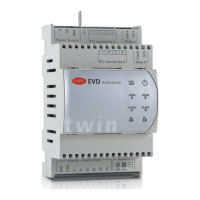ENG
“EVD Evolution TWIN” +0300006EN - rel. 2.6 - 31.01.2019
10
• pressure probes S1 & S2 in the diagram are ratiometric. See the general
connection diagram for the other electronic probes, 4 to 20 mA or
combined;
• the pressure probes S1 and S3 must be of the same type.
2.4 Installation
For installation proceed as follows, with reference to the wiring diagrams:
1. connect the probes: the probes can be installed a maximum distance of
10 metres away from the driver, or a maximum of 30 metres as long as
shielded cables with a minimum cross-section of 1 mm are used;
2. connect any digital inputs, maximum length 30 m;
3. connect the power cable to the valve motors: use 4-wire shielded cable
AWG 22 Lmax=10 m or AWG 14 Lmax=50m; failure to connect the valve
motors after connecting the controller will generate the “EEV motor error”
alarm: see paragraph 9.5;
4. carefully evaluate the maximum capacity of the relay outputs specied in
the chapter “Technical specications”;
5. if necessary, use a class 2 safety transformer with suitable short-circuit
and overload protection. For the power ratings of the transformer see the
general connection diagram and the technical specications;
6. the connection cables must have a minimum cross-section of 0.5 mm
2
;
7. power up the controller: for 24 Vdc power supply the controller will close
the valves;
Important: for 24 Vdc power supply, set “Power supply mode”
parameter=1 to start control. See par. 6.1
Drivers in a serial network
Case 1: multiple controllers connected in a network powered by the same
transformer. Typical application for a series of controllers inside the same
electrical panel
G
G0
VBAT
COMA
NOA
1
3
2
4
2 AT 2 AT
2 AT
230 Vac
24 Vac
pCO
NOA
G
G0
VBAT
1
3
2
4
COMA
NOA
G
G0
VBAT
1
3
2
4
COMA
Fig. 2.d
Case 2:
multiple controllers connected in a network powered by dierent
transformers (G0 not connected to earth). Typical application for a series of
controllers in dierent electrical panels.
2 AT
230 Vac
24 Vac
2 AT
230 Vac
24 Vac
2 AT
230 Vac
24 Vac
pCO
NOA
G
G0
VBAT
1
3
2
4
COMA
NOA
G
G0
VBAT
1
3
2
4
COMA
NOA
G
G0
VBAT
1
3
2
4
COMA
Fig. 2.e
Case 3:
multiple controllers connected in a network powered by dierent
transformers with just one earth point. Typical application for a series of
controllers in dierent electrical panels.
2 AT
230 Vac
24 Vac
2 AT
230 Vac
24 Vac
2 AT
230 Vac
24 Vac
pCO
NOA
G
G0
VBAT
1
3
2
4
COMA
NOA
G
G0
VBAT
1
3
2
4
COMA
NOA
G
G0
VBAT
1
3
2
4
COMA
Fig. 2.f
Important: earthing G0 and G on a driver connected to a serial
network will cause permanent damage to the driver.
NO !
2 AT
230 Vac
24 Vac
2 AT
230 Vac
24 Vac
pCO
NOA
G
G0
VBAT
1
3
2
4
COMA
NOA
G
G0
VBAT
1
3
2
4
COMA
Fig. 2.g
Installation environment
Important: avoid installing the controller in environments with the
following characteristics:
• relative humidity greater than the 90% or condensing;
• strong vibrations or knocks;
• exposure to continuous water sprays;
• exposure to aggressive and polluting atmospheres (e.g.: sulphur and
ammonia fumes, saline mist, smoke) to avoid corrosion and/or oxidation;
• strong magnetic and/or radio frequency interference (avoid installing the
appliances near transmitting antennae);
• exposure of the controller to direct sunlight and to the elements in general.
Important: When connecting the controller, the following warnings
must be observed:
• if the controller is not used as specied in this user manual, the protection
indicated is not guaranteed;
• incorrect connection to the power supply may seriously damage the
controller;
• use cable ends suitable for the corresponding terminals. Loosen each
screw and insert the cable ends, then tighten the screws and lightly tug
the cables to check correct tightness;
• separate as much as possible (at least 3 cm) the probe and digital
input cables from the power cables to the loads so as to avoid possible
electromagnetic disturbance. Never lay power cables and probe cables in
the same conduits (including those in the electrical panels;
• install the shielded valve motor cables in the probe conduits: use shielded
valve motor cables to avoid electromagnetic disturbance to the probe
cables;
• avoid installing the probe cables in the immediate vicinity of power devices
(contactors, circuit breakers, etc.). Reduce the path of the probe cables as
much as possible and avoid enclosing power devices;
• avoid powering the controller directly from the main power supply in the
panel if this supplies dierent devices, such as contactors, solenoid valves,
etc., which will require a separate transformer.
• * EVD EVO is a control to be incorporated in the end equipment, do not
use for ush mount
• * DIN VDE 0100: Protective separation between SELV circuit and other
circuits must be guaranteed. The requirements according to DIN VDE 0100
must be fullled. To prevent infringement of the protective separation
(between SELV circuit to other circuits) an additional xing has to be
provided near to the terminals. This additional xing shall clamp the
insulation and not the conductor”.
2.5 Valve operation in parallel and
complementary mode
EVD evolution twin can control two CAREL valves connected together (see
paragraph 4.2), in parallel mode, with identical behaviour, or in complementary
mode, whereby if one valve opens, the other closes by the same percentage.
To achieve such behaviour, simply set the “valve” parameter (“Two EXV
connected together”) and connect the valve motor power supply wires to
the same connector. In the example shown below, for operation of valve B_2
with valve B_1 in complementary mode simply swap the connection of wires
1 and 3.

